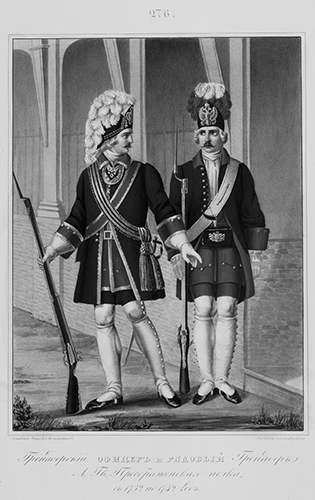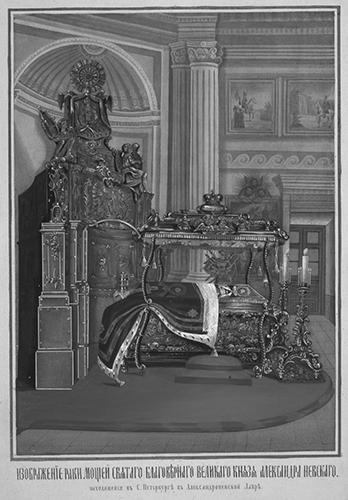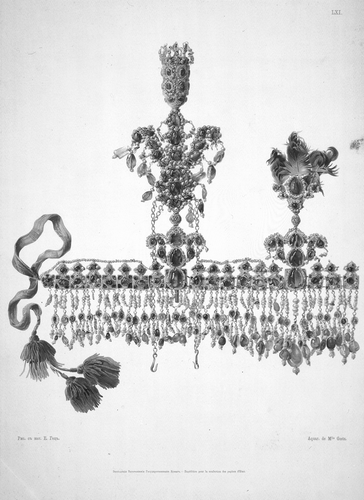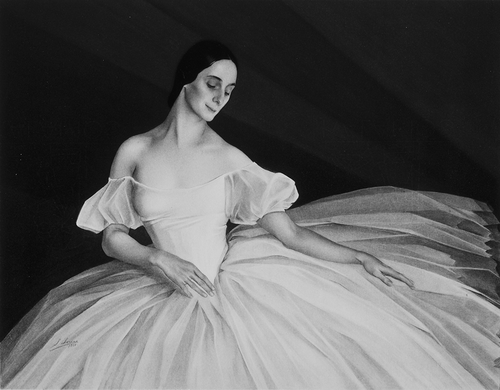Abstract
The imperial Russian collection at Hillwood Estate, Museum & Gardens features some well-known decorative art objects, but the collection's works on paper have never been comprehensively examined. These holdings, housed in the library and museum, consist of original watercolors and drawings, eighteenth-century engravings, nineteenth- and twentieth-century lithographs, chromolithographs, and photographs. Nataliia Sergeevna Goncharova, Mikhail Ivanovich Makhaev, Christina Robertson, Savelii Abramovich Sorine, Vasilii Fëdorovich Timm, and Vasilii Mikhailovich Vasnetsov are among the artists whose works are represented in the collection.
Hillwood Estate, Museum & Gardens houses one of the largest collections of imperial Russian decorative arts outside of Russia, as well as eighteenth-century French and other European decorative arts. Before opening to the public in 1977, Hillwood had been the last home of Marjorie Merriweather Post (1887–1973), an art collector, philanthropist, pioneering businesswoman, socialite, and at one point, the wealthiest woman in the United States. Her exposure to and interest in imperial Russian art stemmed from the time she spent in the Soviet Union when her third husband, Joseph E. Davies, served as the U.S. ambassador there, from 1936 to 1938. Post began assembling her Russian collection with purchases of imperial art sold by the Bolshevik-run government in the 1920s and 1930s and family treasures sold by émigrés on the Western market.Footnote 1
Post bought the twenty-five-acre Hillwood estate in 1955. In converting her home into a museum, she modified the mansion with built-in display cases and hired Marvin Ross as curator. A highly regarded art historian, Ross had expertise in Byzantine art and museum experience at the Brooklyn Museum of Art, the Los Angeles County Museum of Art, and the Walters Art Gallery in Baltimore; he had also been a member of the Advisory Committee at Dumbarton Oaks in Washington, D.C., for nineteen years by the time he began working at Hillwood. Ross cataloged Post's collections, advised her on acquisitions, and implemented standard museum practices.
Ross also began acquiring the reference materials that would become the nucleus of Hillwood's Art Research Library. Today the library is a portal through which the objects in the museum collections can be viewed and interpreted. It emphasizes the study of imperial Russian and European decorative arts from the eighteenth to early twentieth centuries and the broad historical and social contexts within which these objects were created. The library offers access to reference works along with complementary visual materials and books that are objects in their own right, such as the imperial coronation albums from Empress Elizabeth Petrovna to the last tsar, Nicholas II.Footnote 2 Illustrating and documenting the imperial rites of power, these coronation volumes also reveal the varying artistic styles and prevailing print technologies in Russia, for example, engravings and mezzotints in Elizabeth Petrovna's album (see ) and sophisticated chromolithographs in that of Alexander III (see ).Footnote 3
Other works on paper at Hillwood display their imperial provenance through their extravagant embellishments and handwork. Three titles of nobility are hand-illuminated on parchment encased in fabric coverings and include a tassel(s), seal, and silver box. The collection's oldest title of nobility, presented November [25], 1751, was granted by Empress Elizabeth to Filat Anikiev Khludenev in appreciation for his participation in the palace coup ten years earlier. The next oldest is from the reign of Nicholas I and was granted on February 5, 1844, (see ) to the architect Ieronim Dominikovich Korsini (Geronimo Corsini), an architect whose designs include the Apraksin Dvor department store and the cast iron fence for the Sheremetev palace. The third title is from Tsar Alexander III to Matvei Fedorovich Mavrokordato, issued February 23, 1890. That the tradition of handwriting these titles continued into the nineteenth century, a time when printing technologies had generally replaced handwork, reinforces how special and unique they were as presentation pieces.
Handcrafted documents continued to impress into the twentieth century and do so to this day. In 1940 the Hammer Galleries commemorated a 1939 benefit exhibition of imperial Fabergé Easter eggs by presenting Marjorie Merriweather Post (Davies) with a hand-illuminated manuscript entitled “Imperial Russian Easter Egg: 1914.” Preserved at Hillwood, it describes the history of the eggs and celebrates her Catherine the Great Easter Egg designed by the firm of Fabergé. Tsar Nicholas II had presented the egg to his mother, Maria Fedorovna, in 1914 on Easter. Tipped-in at the back of the manuscript is an excellent painting of the egg.
UNIQUE WORKS ON PAPER
Hillwood possesses thirty-four drawings on paper by Fabergé in addition to objets d'art by the firm. The illustrations are primarily of small items, such as combs and brooches (see ); there is also one of a ladle. Other drawings in the collection include a pastel of Nicholas II by Mikhail Viktorovich Rundaltsov (1871–1935), three images of peasant women attributed to Filipp Andreevich Maliavin (1869–1940), and Saint and Woman by Mikhail Vasilievich Nesterov (1862–1942). A drawing of a scene from Taras Bulba by Mikhail Shemiakin (b. 1943) was a gift in 2006 from Edward Kasinec, a scholar at the Harriman Institute and curator emeritus of the former Slavic and Baltic Division at the New York Public Library.Footnote 4 Also forming part of Hillwood's collection is a graphite portrait of Colonel Serge Obolensky, a good friend of Post, by Savelii Abramovich Sorine (1878 or 1887–1953).
Examples of other original artists' works on paper include several watercolors: two of Nicholas I attributed to Christina Robertson (1796–1854) (see ), four Moscow street scenes by A. Lozhkin (see ), Adolf Charlemagne's (1826–1901) impression of a seventeenth-century Palm Sunday procession, a portrait of Nicholas II attributed to Vsevolod Strekalovskii, a 1920s view of Revolution Square in the city of Kostroma by the historian Georgii Kreskent'evich Lukomskii (1884–ca. 1928) (see ), and three studies by Vladimir Vasilevich Lebedev (1891–1967). A unique album of watercolors contains two paintings by the portrait artist Petr Sokolov (1791–1847 or 1848) (see ). This volume, a collection of forty-five portraits of important diplomatic and court figures from St. Petersburg during the first quarter of the nineteenth century, was compiled by the descendants of Henry Middleton, U.S. minister to Russia from 1820 to 1830. Middleton's daughter Maria Henrietta is most likely the creator of the other images in the album.
Hillwood also owns several small paintings and drawings by anonymous artists, examples of which include an early nineteenth-century young naval officer surrounded by military trophies and an imperial gentleman. Imperial portraits include one of Tsar Alexander II; one of Elizabeth, the wife of Tsar Alexander I; and one each of Grand Duke Konstantin Nikolaevich and Grand Duchess Alexandra Nikolaevna, children of Tsar Nicholas I.
HANDWORK TO ENHANCE PRINTED WORKS
Several documents at Hillwood combine the printed image with hand painting. The Belossel'skii-Belozerskii collection includes a set of five boxes covered in green, tooled and gilt morocco, which holds twenty-six smaller boxes, each of which contains lithographed images of flags and standards of the Russian regiments. The images are printed on three-by-four-inch cards and hand painted. Groups of cards are pasted onto a piece of approximately twenty-by-thirty inch linen trimmed with green satin, which is folded to fit into a protective slip-cover and box. Dating from the mid-nineteenth century, the set is most likely imperial, based on the binding. The State Hermitage Museum in St. Petersburg holds the only other known set similar to the one at Hillwood (see ).Footnote 5
The Belossel'skii-Belozerskii collection also includes an incomplete hand-colored copy of Aleksandr Viskovatov's Istoricheskoe opisanie odezhdy i vooruzheniia rossiiskikh voisk [Historical description of the clothes and arms of the Russian army] (see ).Footnote 6 It was reputedly given by Tsar Nicholas I to the Prussian king Wilhelm Friedrich IV, his brother-in-law, and sold from the Prussian Royal Library in the 1920s.Footnote 7 The Avinoff-Shoumatoff collection includes Izobrazheniie chudotvornykh ikon i grobnits sviatykh moshchei [Representation of miracle-working icons and sepulchers of holy relics], a single portfolio of eight lithographed plates by the artist Andrei Dmitrievich Losev (d. 1891) (see ).Footnote 8 The dedication from Losev to Grand Duke Nikolai Nikolaevich (the Elder) dated April 3, 1859, is hand painted, as are all the other plates.
ENGRAVINGS
In addition to the previously mentioned coronation album of Empress Elizabeth Petrovna, Hillwood possesses several other engraved objects of note. Among them are two mezzotints of Peter III as grand duke and Catherine II as grand duchess by Johann Stenglin (1715–1770), after originals by Georg Christoph Grooth (1716–1749), the same engraver who created the mezzotint of Empress Elizabeth in her album (see ). Another highlight is the set of eighteenth-century engravings gathered and bound by a member of the Belossel'skii-Belozerskii family.Footnote 9 Consisting of forty-two engravings, it contains works by Aleksei Fedorovich Zubov (1682–1751) and Mikhail Ivanovich Makhaev (1718–1770) and images of Peter the Great, maps, monasteries, battle plans, coastlines, and flags among other representations.
Acquisition of the Avinoff-Shoumatoff collection brought to Hillwood a set of fourteen views of St. Petersburg after Mikhail Makhaev and all the major volumes on Russian art written by the art historian, art collector, academician, and lawyer Dmitrii Rovinskii. The Rovinskii titles are all folio size and filled with tipped-in original prints from his own collection. There are portraits of Moscow rulers Ivan III, Ivan IV, and ambassadors of their time;Footnote 10 materials on Russian iconography;Footnote 11 and Russian popular prints (lubki).Footnote 12
Another book, Divers ajustements et usages de Russie [Diverse settlements, attire, and customs of Russia], consists entirely of engravings by the French artist Jean-Baptiste Le Prince (1734–1781), who travelled through Russia and published his various drawings of the countryside, its people, and genre scenes.Footnote 13 Two titles from the George Dunning collection are also engraved: P. Ricaud de Tiregale's Médailles sur les principaux évènemens [sic] de l'empire de Russie depuis le règne de Pierre le Grand jusq'a celui de Catherine II [Medals on the main events of the Russian Empire from the reign of Peter the Great to Catherine II], and Count Fedor Tolstoi's Medaliony v pamiat' voennykh sobytii [Medals in memory of the military events].Footnote 14
LITHOGRAPHS AND CHROMOLITHOGRAPHSFootnote 15
Hillwood has nineteenth- and twentieth-century lithographs depicting imperial Russian rulers and the royal family, genre scenes of daily life or imperial festivities (including coronations), views of Moscow and St. Petersburg, and buildings (such as the Anichkov, Peterhof, Tauride, and Winter palaces).Footnote 16 English and Dutch artists—including Thomas Witlam Atkinson (1799–1861), J. Carr, H. Bibby, and E. Maaskamp—and Russian artists and lithographers—among them Karl Beggrov (1799–1875), Karl Gampeln (1794–after 1883), and George Dawe (1781–1829)—are represented in the collections. In addition, there are two lithographs by the influential German-Baltic artist Vasilii Fëdorovich Timm (1820–1895) and the 1859 volume of Russkii khudozhestvennyi listok [Russian artistic bulletin].Footnote 17 Timm used his bulletin to focus on Russian art and artists as opposed to those in the West.
The collection contains chromolithographed menus designed for the imperial coronations by such artists as Viktor Mikhailovich Vasnetsov (1848–1926), E. P. Samokish-Sudkovskii, and Alexandre Benois (1870–1960), as well as a 1933 menu for an émigré dinner in Paris to commemorate the two hundred fiftieth anniversary of the Preobrazhenskii regiment. Another work based on the collection of S. N. Shakhovskaia, intricately illustrates eight designs of ancient Russian embroideries (see ).Footnote 18 George Dunning donated two atlas folios (each 29 x 21 inches). One of them—Kavkazskie kovry: al'bom ispolnitel'nykh risunkov dlia kustarei [Causasian carpets: an album of sample drawings executed for craftsmen]—is a set of chromolithographs printed in 1913 after the drawings of Iu. Straume (see ). The other portfolio, a set of nearly forty-three chromolithographs, illustrates carpets from the collection of A. A. Bogoliubov.Footnote 19
FIGURE 12 Book cover design from Dessins d'anciennes broderies en Russie = Uzory starinnago shit'ia v Rossii [Designs of ancient embroidery in Russia].
![FIGURE 12 Book cover design from Dessins d'anciennes broderies en Russie = Uzory starinnago shit'ia v Rossii [Designs of ancient embroidery in Russia].](/cms/asset/bf6f7066-279b-4bcf-b2b7-46c60ef5c7e7/wsee_a_496108_o_f0012g.gif)
Judith Robinson donated the folio set Obraztsy dekorativnago i prikladnogo iskusstva iz imperatorskikh dvortsov tserkvei i kollektsii v Rossii [Samples of decorative arts from imperial palaces, churches, and collections in Russia], printed in St. Petersburg from 1901 to 1908.Footnote 20 This is a group of richly chromolithographed plates that illustrate various objects held in imperial collections. It not only serves as a catalog of objects, but also demonstrates the technological expertise and skilled use of chromolithography that the Russians developed and the role played by important supporters and patrons, such as the Society for the Encouragement of the Arts, which published this work (see ).
BEYOND LITHOGRAPHY
Other illustrated objects in the collection include Savelii Sorine's Portraits, a collection of finely printed color and sepia images after his originals (see ).Footnote 21 Several mechanical reproductions of The Boyar Wedding Feast, one of Hillwood's best-known paintings, are also part of the collection.Footnote 22 The library holds two donated copies of Al'bom kostiumirovannago bala v Zimnem Dvortsie, v fevralie 1903 g. [Album of the costume ball in the Winter Palace, in February 1903], a collection of phototypes depicting attendees and costumes from the 1903 Boyar Ball held at the Winter Palace.Footnote 23
An elaborate publication commemorating the Feodorov Sovereign Cathedral at Tsarskoe Selo—the cathedral commissioned by the last tsar, Nicholas II, and his wife, Alexandra, to evoke a seventeenth-century religious aesthetic—integrates text and image, has two colors of ink, and brocade silk covers and a silk bookmark with designs reflecting the subject of the book. Hillwood's copy is from the Avinoff-Shoumatoff collection.Footnote 24 The library also has a German translation of the academician Count Aleksei Bobrinskii's book on Russian woodworking of folk, home, and church handcrafts, containing 163 plates, and a second Russian edition, with 200 plates.Footnote 25
A folio set of photogravures richly illustrates seventeenth- and eighteenth-century French furniture in imperial Russian and private collections. There are 100 plates in two volumes, with each image accompanied by a descriptive sheet that has been letterpress printed (see ).Footnote 26 Russia's Treasure of Diamonds and Precious Stones, a folio plate book published in an edition of 350 by the Soviet government's People's Commissariat of Finance in 1925, is an important historical document lending insight into Soviet sales of art and decorative objects in the early years of the republic. It is also an excellent example of high-quality printing with plates producing a tonality of varying shades of blacks, browns, and grays. Also from the Soviet period is a print of a portrait of Marshal Kliment Voroshilov that Marjorie Merriweather Post received as a gift from him on March 28, 1937.
PHOTOGRAPHS
The photographs in the collection are wide-ranging, from images of the imperial family to a 1946 photograph inscribed to Marjorie Merriweather Post (Davies) from Svetlana Molotova, daughter of the Russian foreign minister when Post and Davies lived in Moscow. There is also a photograph of the Russian artist Ivan Aivazovskii (1817–1900) seated in his studio, looking at an easel that holds a frame with one of his seascapes painted in miniature. Aivazovskii purportedly made 150 of these to present to a group that had honored him at a fifty-year jubilee celebration of his artistic career.
There are three (uncataloged) Dunning collection photograph albums from the early twentieth century with scenes of army life in the field and around the barracks and of Tsar Nicholas II inspecting the troops. An album marking the 1933 reunion of the Cuirassier regiment in Paris has the signatures of the attendees on a souvenir card and features images of the men on their horses and in the countryside. Two other albums, given to Hillwood by Serge Cheremeteff (Sheremetev), contain photographs of imperial Russia, in particular the Preobrazhenskii regiment and its barracks and officers, members of the imperial family, including Tsar Nicholas II, and Cheremeteff family members and their houses.
In 1972 Alice Dodge gave an album to Hillwood containing twelve sepia photographs, a few of which are hand colored, portraying monuments of St. Petersburg and its suburbs, Moscow, and Siena, Italy. It documents a trip made by Dodge's grandfather Henry Dodge in 1887 and 1888. In 1978 former Hillwood trustee Rodion Cantacuzene donated a photograph album that had belonged to his grandmother Julia Grant Cantacuzene. The granddaughter of President Ulysses S. Grant, who married the Russian count Michael Cantacuzene/Speransky, Julia had been a longtime friend of Marjorie Merriweather Post and had led a refugee program in the United States. The photograph album has forty-nine black-and-white images of a Russian refugee camp on the Greek island of Lemnos.
CONCLUSION
Hillwood's collections are quite rich in the forms and genres of the visual arts they contain. They are invaluable as well in allowing one to research the objects in catalogs, references, and manuscripts in the library and to examine them firsthand minutes earlier or later in their museum setting. Another distinction of the library at Hillwood is the opportunity it offers to study the imperial Russian book as an object. The library's resources provide a snapshot of the history of the Russian book, from early Bibles, eighteenth-century engravings, nineteenth-century imperial coronation albums, to early twentieth-century folios of chromolithographs.
The collections assembled by Marjorie Merriweather Post, in tandem with curator Marvin Ross, have been enlarged by the library and curatorial staff and the generosity of numerous donors. As noted, Ross was the driving force behind the creation of Hillwood's library; it was after his coming aboard as curator of Hillwood's art collections that Post began to focus more seriously on obtaining works on paper, especially imperial Russian materials that complemented her art objects. Hillwood continues to expand the holdings of works on paper, and in doing so, furthers the work and vision of Post and Ross.Footnote 27
Notes
This essay is based on the panel presentation “‘Treasure Troves’ of Works on Paper for the Study of Russian and Eastern European Art and Architecture: Little-known Resources in Washington, DC,” at the annual meeting of the American Association for the Advancement of Slavic Studies, November 18, 2006.
All images are courtesy of Hillwood, Estate, Museum & Gardens.
1. For more on the phenomenon of the Soviet sales, see Anne Odom and Wendy Salmond, eds., Treasures into Tractors: The Selling of Russia's Cultural Heritage, 1918–1938 (Washington, DC: Hillwood Estate, Museum & Gardens, 2009).
2. The only coronation volume the library lacks is Anna Ioannovna's. Three of the five albums come from the Prince Belossel'skii-Belozerskii collection, acquired by Marvin Ross in 1968. The prince was a member of the Imperial Horse Guard regiment while living in Russia and later became a prominent member of the émigré community, residing in New York City.
3. For a history of the albums, see Edward Kasinec and Richard Wortman, “Russian coronation albums,” Biblion: the bulletin of the New York Public Library 1 (1992): 82–86; Richard Wortman, Scenarios of Power: myth and ceremony in Russian monarchy (Princeton, N.J.: Princeton University Press, 1995). See also, Irina Tarsis's essay in this journal for a discussion of the coronation albums.
4. Kasinec's 2006 gift consisted of three lithographs by Nataliia Sergeevna Goncharova, a lithograph by Goncharova and Vladimir Vasilevich Lebedev, a drawing by Mikhail Shemiakin, and three prints illustrating costumes by Léon Bakst for the Ballets Russes.
5. Tablitsy: risunkov mundiram znamenam i shtandartam imperatorskikh Rossiiskikh voisk [Plates: drawings of uniforms, flags, and standards of the imperial Russian army] [1851].
6. Aleksandr Vasil'evich Viskovatov, Istoricheskoe opisanie odezhdy i vooruzheniia rossiiskikh voisk, sostavlennoe po Vysochaishemu povelieniiu [Historical description of the clothes and arms of the Russian army, compiled by order of His Majestry.] (St. Petersburg: V Voennoi tip., 1840). Hillwood has volumes 2 (1–6) and 3 (1–3). See Irina Tarsis's essay in this issue for more on this publication.
7. Marvin Ross to S. Dillon Ripley, secretary of the Smithsonian Institution, February 16, 1968. Belosselsky file, Hillwood Library.
8. The Avinoff-Shoumatoff collection consists of more than 320 titles, primarily on subjects of personal interest to Avinoff. These include Russian antiquity, art and architecture, icons, and religion. Purchased in 2001 from the heirs of Andrei Avinoff and his sister Elizabeth Shoumatoff, a renowned portraitist, the collection's importance to the library cannot be overstated, as it greatly enhances its holdings of illustrated materials. For more information on the extraordinary biography and art of Andrei Avinoff, see Louise Lippincott, Andrey [sic] Avinoff: In Pursuit of Beauty (Pittsburgh, PA: Carnegie Museum of Art, forthcoming).
9. Prince Konstantin Belossel'skii-Belozerskii, Old Prints: From an Album of Prince Konstantine [sic] Belosselsky-Belozersky [18–].
10. Dmitrii Aleksandrovich Rovinskii, Dostoviernye portrety moskovskikh gosudarei Ivana III, Vasilia Ivanovicha i Ivana IV groznago, i posol'stva ikh vremeni [Authentic portraits of the Moscow sovereigns Ivan III, Vasilii Ivanovich, and Ivan IV the Terrible, and embassies of their time] (St. Petersburg: Ekspeditsiia zagotovleniia gosudarstvennykh bumag, 1882).
11. Dmitrii Aleksandrovich Rovinskii, Materialy dlia russkoi ikonografii [Materials for Russian iconography] (St. Petersburg: Ekspeditsiia zagotovleniia gosudarstvennykh bumag, 1884–1891).
12. Dmitrii Aleksandrovich Rovinskii, Russkiia narodnyia kartinki [Russian folk pictures] (St. Petersburg: Ekspeditsiia zagotovleniia gosudarstvennykh bumag, 1881–1893).
13. Jean-Baptiste Le Prince, Divers ajustements et usages de Russie [Diverse settlements, attire, and customs of Russia] (Paris, 1775).
14. In 2000 George Dunning gave the library more than 250 books, several of which are rare and heavily illustrated. The titles referenced here are P. Ricaud de Tiregale, Médailles sur les principaux évènemens [sic] de l'Empire de Russie depuis le règne de Pierre le Grand jusqu'à celui de Catherine II avec des explications historiques [Medals on the main events of the Russian Empire from the reign of Peter the Great to Catherine II] (Potsdam: Sommer, 1772); Fedor Petrovich Tolstoi, Count, and Nikolai Mentsov, Medaliony v pamiat voennykh sobytii 1812, 1813, 1814 i 1815 godov [Medals in memory of the military events of 1812, 1813, 1814, and 1815] (St. Petersburg: Izd. Arkheograficheskoiu Kommissieiu, 1838).
15. See Irina Tarsis's essay in this issue for a brief history of lithography and chromolithography and its use in Russia.
16. In a 1962 letter, Princess Julia Grant Cantacuzene writes to Marjorie Merriweather Post that Marvin Ross had told her that Post was collecting “Prince [sic] and little ocquerelles [sic] of palaces and buildings in Russia” for the museum at Hillwood. The princess wanted to give Post a lithograph of Peterhof if she did not already have one. Curatorial file 55.10, Hillwood Estate, Museum & Gardens.
17. Vasilii Timm, Russkii khudozhestvennyi listok [Russian artistic bulletin] (Saint Petersburg: V Tipografii Gubernskago Pravleniia, 1851–1862). Hillwood's issue is from the Belossel'skii-Belozersky collection.
18. S. Schachoffskoy (S. N. Shakhovskaia) and Th. Bousslaieff, Dessins d'anciennes broderies en Russie = Uzory starinnago shit'ia v Rossii: sobrannye i izdannye kniazhnoiu S. N. Shakhovskoiu s predisloviem O. Buslaeva, vypusk 1) [Designs of ancient embroidery in Russia] (Moscow: V. Bakhman, 1885).
19. Andrei Andreevich Bogoliubov, Kovrovyia izdieliia Srednei Azii iz sobraniia sostavlennago A. A. Bogoliubovym = Tapisseries de l'Asie Centrale faisant partie de la collection réunie par A. A. Bogolubow [Central Asian carpets from the collection of A. A. Bogoliubov] (St. Petersburg: Ekspeditsiia zagotovleniia gosudarstvennykh bumag, 1908).
20. Objets d'art décoratif recueillis dans les palais impériaux, églises et collections en Russie = Obraztsy dekorativnago i prikladnogo iskusstva iz imperatorskikh dvortsov tserkvei i kollektsii v Rossii [Objects of decorative arts in the imperial palaces, churches, and collections in Russia] (St. Petersburg: Expédition pour la confection des papiers d'État, 1901–1908).
21. S. Sorine, Portraits (Berlin: Edition Ganymed, 1929). Nineteen of the thirty-four reproduced portraits are missing from Hillwood's copy, including an image of Col. Obolensky. It has not yet been determined which original image of Obolensky the reproduction portrays.
22. See Helena Wright's essay in this journal for reference to an American chromolithograph example at the National Museum of American History, Smithsonian Institution.
23. One copy is from the Belossel'skii-Belozerskii collection and the other is from the Dunning collection.
24. Feodorovskii gosudarev sobor v Tsarskom sele [Feodorov Sovereign Cathedral at Tsarskoe Selo] (Moscow: T-vo skoropechatni A. A. Levenson, 1915). In 2004 Edward Kasinec donated an altar cloth and a liturgical vestment by the textile firm A. i V. Sapozhnikovy. The altar cloth, from the Feodorovskii Cathedral chapel, was previously in the collection of Paul M. Fekula.
25. The German translation is Aleksei Alekseevich Bobrinskii, Count, Volkstümliche russische Holzarbeiten: Hausindustrie, Haushaltungs- und Kirchengeräte (Leipzig: K. W. Hiersemann, 1913). The Russian original is Aleksei Alekseevich Bobrinskii, Count, Narodnyia russkiia dereviannyia izdieliia: predmety domashniago, khoziaistvennago i otchasti tserkovnago obikhoda [Russian woodworking: folk, home, and church handcrafts], 2nd ed. (Moscow: A. A. Levenson, 1911). Alex Rabinovich donated the second edition.
26. Denis Roche, Le mobilier français en Russie: meubles des XVIIe et XVIIIe siècles et du commencement du XIXe, conservés dans les palais et les musées impériaux et dans les collections privées [French furniture in Russia: furniture of the seventeenth, eighteenth, and beginning of the nineteenth centuries in the imperial palaces and musuems, and in private collections] (Paris: E. Lévy, 1913).
27. For more information about Hillwood and its collections, visit the Hillwood Estate, Museum & Gardens Web site, http://www.hillwoodmuseum.org/. The library catalog is accessible at http://www.dcdata.com/hillwood/ and the museum collections database at http://trio.hillwoodmuseum.org/. To make an appointment to visit the collections, contact Pat Lynagh at [email protected].
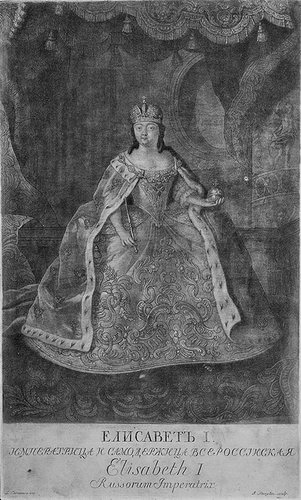
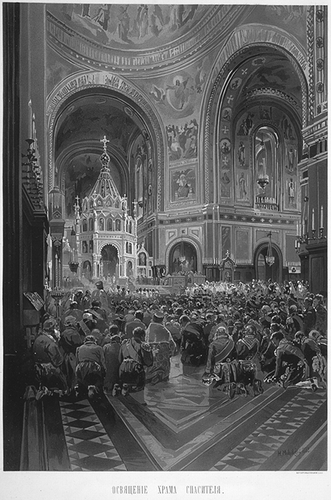
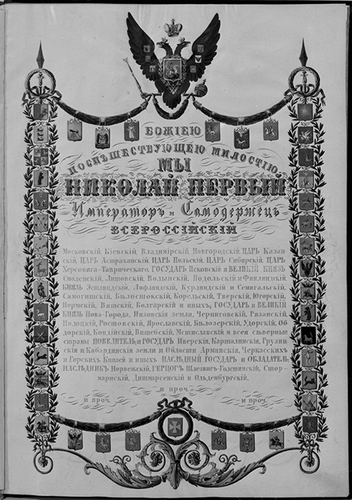
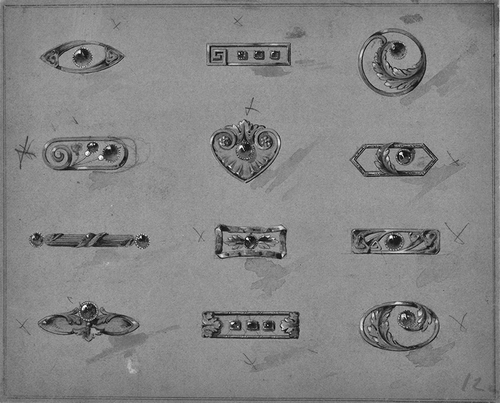
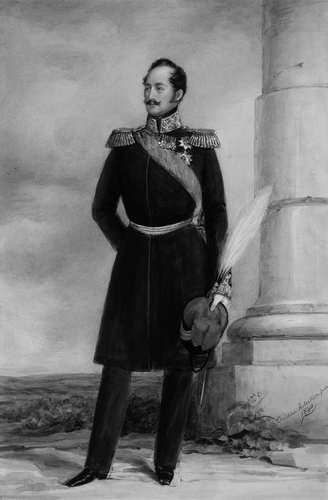
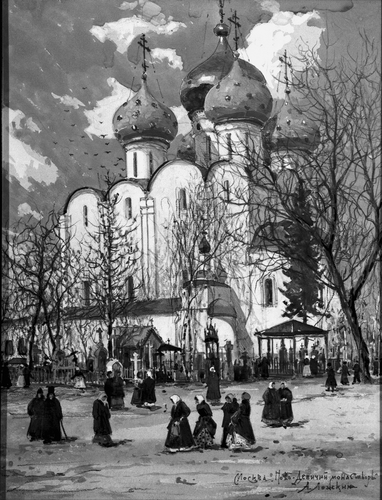
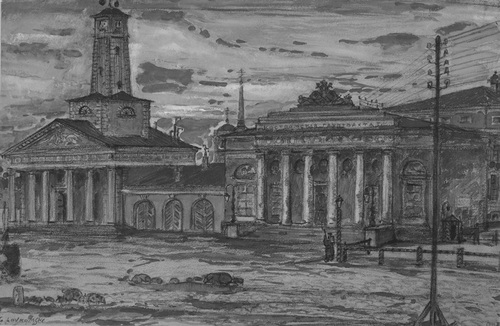
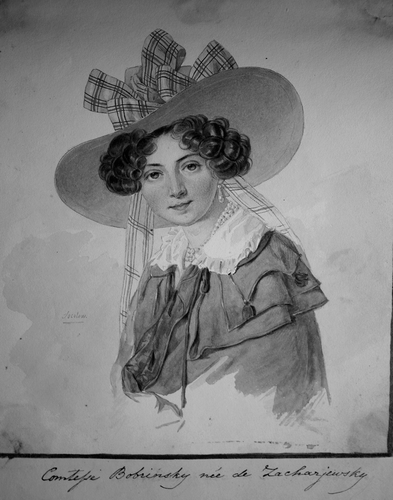
![FIGURE 9 Bird's-eye view of Tablitsy [Plates].](/cms/asset/6116fa2e-df2f-4fce-a5c1-3642d9f0bd50/wsee_a_496108_o_f0009g.gif)
